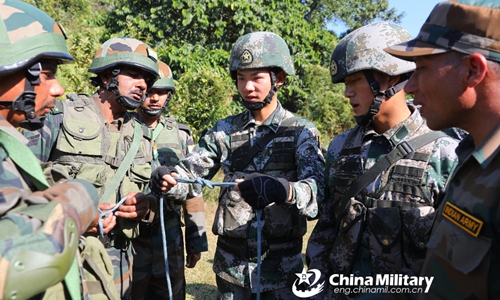If the US highest military officer, the Chairman of the Joint Chiefs of Staff Committee were to issue a military threat to China on the South China Sea, an appropriate response from the People’s Liberation Army (PLA) would be assured. When India’s Chief of Defence Staff, General Bipin Rawat recently said that the military option was on the table if IndiaChina talks on Ladakh fail, there was deafening silence from the PLA.
The reason was simple: Discerning observers of new age technologies understood that either General Rawat was grandstanding, or was simply out of his depth on the changed character of warfare.
The huge gap between the technologies and the concept of operations or the art of war-fighting between the PLA and the Indian military could perhaps be explained by the analogy of the 1991 Gulf War. The war lasted 43 days of which the ground war was a mere 100 hours, essentially a mopping up operation. The Iraqi army’s elite Republican Guards battle-hardened in the decade long war with the neighbouring Iran were beaten by the US technology without a fight.
The world, especially the PLA, was dumbstruck by the US’ new concept of warfare pivoted on stealth, guided munitions, stand-off ranges, and above all battle network centricity (real time connectivity between sensor, shooters and command post).
The PLA was quick to understand that it did not have the technology, scientific-industrial infrastructure, and finances to match the US military’s technological superiority. But it could develop ‘systems destruction warfare’ — capability to cripple US battle network’s command, control, communication, and intelligence systems — to deny or delay information to the enemy which is crucial for timely decision-making in war.
This was sought to be done by both non-kinetic and kinetic means, namely, by focussing on cyber and electronic warfare, and missiles (ballistic and cruise) capabilities. By early 2000, the PLA’s ‘assassin’s mace’ capabilities meant to incapacitate the enemy, suddenly and totally, by denying him information, instead of fighting him directly, had caught the US military’s attention.
A bigger shock awaited the US military when by 2012, it realised that the PLA had become a peer competitor in Artificial Intelligence (AI) and eleven new age disruptive technologies poised to reshape warfare and geopolitics while ushering in the fourth industrial revolution for prosperity.
These technologies are microelectronics, cyber, 5G wireless communications, space, hypersonic, directed energy weapons, autonomy, network communications, missile defence, quantum technologies, and nuclear triad. In certain technologies like 5G, AI and quantum, China was suspected to be ahead of the US.
This resulted in the US announcing its Third Offset strategy in 2014 to focus on robotics, autonomy and human-machine fusion. The Third Offset strategy, meant to meet China’s challenge, was testimony to the PLA’s technology driven upward trajectory for war-fighting.
Unfortunately, Indian military leaders fixated on Pakistan and counter-terror operations for 30 years since 1990 had completely missed the burgeoning challenges on the Line of Actual Control (LAC) with the PLA.
This is especially true for General Rawat who was deep selected for his stated expertise in counter terror operations to become the army chief in December 2016. Since the PLA is not the Pakistan military, it should have been obvious that a new template for warfare would be needed to check China. Surely, the PLA will not fight to Indian Army’s strength which is battle-hardened manpower. It would instead fight to its own strength: technology. When the CDS threatened China, he betrayed ignorance of PLA’s grown war-fighting capabilities. It was also lost on him and most analysts that the 2017 Doklam and the Ladakh crisis are as dissimilar as chalk and cheese.
Assuming that General Rawat is reckless and decides to execute his manpower-centric plan by opening up a new front on the 3,488km long LAC to put pressure on the PLA to evict occupied territory in eastern Ladakh; once the first shot is fired from the Indian side, an instant response from the PLA with four likely simultaneous actions based on its capabilities is certain.
One, there could be a massive cyber offensive culminating in cyberwar involving the whole-of-nation way beyond the designated battlespace. Since Chinese companies are embedded in India’s telecommunications, power, information and communications, and defence grids, it is anyone’s guess what a cyberwar (the world has never seen this) in virtual battlespace would do. There would be panic, fear, and frenzy in commercial and financial sectors with the government at its wit’s end.
Two, the PLA would unleash its ‘systems destruction’ strategy by its two organisations which report directly to the Central Military Commission, China’s highest military policy making body. These are the Strategic Support Force comprising cyber, space, electronic and psychological capabilities, and the Rocket Force which has under it all ballistic, cruise and hypersonic missiles.
Given this, India’s space satellites would be hit by cyber malware, PLA’s sub-orbital kill satellites and anti-satellite capabilities. Also hit would be command centres, various field headquarters and airfields to name a few critical information nodes. The overall PLA objective would be to deny information to Indian military for timely decision-making. This would result in the PLA getting ahead on the decision-making loop, allowing it faster responses. Importantly, the PLA has fielded AI technology enabler into its warfare. This would affect all aspects of war-fighting—quicker and better Intelligence, Reconnaissance and Surveillance (ISR), early decision-making and accurate and standoff responses.
Two examples would help show the uses of AI, which is still in early stages of development, in war. The PLA is known to have AI in its weapons including cruise missiles. This means that cruise missile would be autonomous and intelligent, capable of identifying targets and destroying them without help from ground controller.
Moreover, the PLA has demonstrated capability of one ground station controlling large numbers of drones or unmanned aerial vehicles. It is certain that Indian military’s trained manpower pitted against technology would not achieve its objective of evicting the PLA from occupied territories. This is what makes General Rawat’s warning unreal.
Middle East crisis: US shuts Jerusalem e…
17-06-2025
Amid escalating military tensions between Iran and Israel, the United States will close its embassy in Jerusalem from Wednesday through Friday. This decision follows missile strikes in Jerusalem and Tel...
Read moreKristi Noem hospitalised: US homeland se…
17-06-2025
US Homeland Security Secretary Kristi Noem was hospitalised in Washington, D.C., on Tuesday after suffering an allergic reaction. The 53-year-old was taken to the hospital as a precaution and is...
Read moreDay 2 at G7: PM Modi highlights terroris…
17-06-2025
G7 summit saw discussions on terrorism and Ukraine war. PM Narendra Modi addressed the Outreach Session. He met with leaders including Mark Carney and Emmanuel Macron. They discussed trade and...
Read moreTank fire kills 51 people trying to get …
17-06-2025
Israeli tanks opened fire on a crowd awaiting aid trucks in the Gaza Strip on Monday, resulting in the deaths of at least 51 people, according to medics. The incident...
Read moreSuspected Israeli hackers claim to destr…
17-06-2025
An anti-Iranian government hacking group, Gonjeshke Darande, claimed responsibility for a cyberattack on Iran's state-owned Bank Sepah. The group, potentially linked to Israel, asserted it destroyed data due to the...
Read more'Need to be careful': Canadian PM Mark C…
17-06-2025
During the G7 Summit, Canadian PM Mark Carney addressed the Hardeep Singh Nijjar case, emphasizing the need for law enforcement cooperation with India while respecting the ongoing judicial process. Tensions...
Read moreWho was Anne Burrell? Celebrity chef and…
17-06-2025
Chef and television personality Anne Burrell has passed away at her home in Brooklyn at the age of 55. Known for her vibrant personality and culinary expertise, she was a...
Read more‘The battle begins’: Khamenei vows to sh…
17-06-2025
Tensions escalate as Iran's Supreme Leader Ayatollah Ali Khamenei declares “the battle begins” following threats from US President Trump. Iran launched ballistic missiles at Israel, prompting retaliatory airstrikes in Tehran...
Read moreUS may join strikes on Iran; Tehran used…
17-06-2025
Tensions escalate as the Iran-Israel conflict enters its sixth day, marked by airstrikes and missile exchanges. The US has issued over 30 security alerts in the Middle East, with potential...
Read more'Extreme thuggery of Trump’s ICE': NYC m…
17-06-2025
New York City Comptroller Brad Lander, a Democratic mayoral candidate, was arrested at a Manhattan immigration court after linking arms with a man federal agents were attempting to detain. Agents...
Read morePrince Louis steals the show at royal pa…
17-06-2025
Prince William and Princess Kate's children, Prince George, Princess Charlotte, and Prince Louis, captivated onlookers at the Trooping the Colour ceremony. Prince Louis, in particular, charmed royal enthusiasts with his...
Read moreIsrael-Iran war: Donald Trump may consid…
17-06-2025
President Trump is considering US involvement in Israel's strikes on Iranian nuclear facilities, hinting at potential support amid escalating tensions. He has expressed a desire for Iran's "UNCONDITIONAL SURRENDER!" and...
Read moreToy company challenges Trump tariffs at …
17-06-2025
Learning Resources Inc. is escalating its fight against Trump's tariffs to the Supreme Court, arguing the former president overstepped his authority. The company emphasizes the urgent need for a ruling...
Read moreQatar monitors radiation levels over Gul…
17-06-2025
Amid escalating conflict between Israel and Iran, Qatar has intensified monitoring of radiation levels in the Gulf following Israeli airstrikes on Iranian nuclear and energy sites. Doha is closely tracking...
Read moreIran urges public to delete WhatsApp; cl…
17-06-2025
Iranian state television has urged citizens to delete WhatsApp, alleging data collection and sharing with Israel, claims WhatsApp vehemently denies. The messaging app emphasises its use of end-to-end encryption, ensuring...
Read moreWho is Huma Abedin? Indian-origin ex-aid…
17-06-2025
Huma Abedin, an Indian-origin author, married Alex Soros. Alex is the son of George Soros. The wedding occurred in New York. Many prominent figures attended the event. Hillary and Bill...
Read moreReview finds UK police and councils cove…
17-06-2025
A UK audit, prompted by Elon Musk and released Monday, reveals that police and councils concealed the Asian ethnicity of grooming gang perpetrators to avoid accusations of racism. The report...
Read more


















